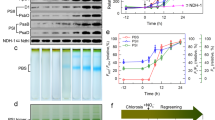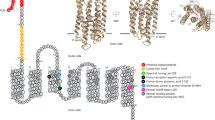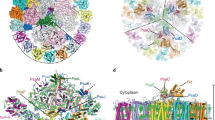Abstract
Although iron is the fourth most abundant element in the Earth's crust, its concentration in the aquatic ecosystems—particularly the open oceans—is sufficiently low to limit photosynthetic activity and phytoplankton growth1,2. Cyanobacteria, a major class of phytoplankton, respond to iron deficiency by expressing the ‘iron-stress-induced’ gene, isiA(ref. 3). The protein encoded by this gene has an amino-acid sequence that shows significant homology with one of the chlorophyll a-binding proteins (CP43) of photosystem II (PSII)4,5. The precise function of the CP43-like protein, here called CP43′, has not been elucidated, although there have been many suggestions3,6. Here we show that CP43′ associates with photosystem I (PSI) to form a complex that consists of a ring of 18 CP43′ molecules around a PSI trimer. This significantly increases the size of the light-harvesting system of PSI. The utilization of a PSII-like protein as an extra antenna for PSI emphasises the flexibility of cyanobacterial light-harvesting systems, and seems to be a strategy which compensates for the lowering of phycobilisome and PSI levels in response to iron deficiency.
This is a preview of subscription content, access via your institution
Access options
Subscribe to this journal
Receive 51 print issues and online access
$199.00 per year
only $3.90 per issue
Buy this article
- Purchase on Springer Link
- Instant access to full article PDF
Prices may be subject to local taxes which are calculated during checkout




Similar content being viewed by others
References
Martin, J. H. et al. Testing the iron hypothesis in ecosystems of the equatorial Pacific Ocean. Nature. 371, 123–129 (1994).
Behrenfeld, M. J., Bale, A. J., Zbigniew, S. K., Aiken, J. & Falkowski, P. G. Confirmation of the iron limitation of phytoplankton photosynthesis in the equatorial Pacific Ocean. Nature 383, 508–511 (1996).
Straus, N. A. in Molecular Biology of Cyanobacteria (ed. Bryant, D. A.) 731–750 (Kluwer Academic, Dordrecht, 1994).
Burnap, R. L., Troyan, T. & Sherman, L. A. The highly abundant chlorophyll-protein complex of iron-deficient Synechococcus sp. PCC7942 (CP43′) is encoded by the isiA gene. Plant Physiol. 103, 893–902 (1993).
Falk, S., Samson, G., Bruce, D., Hunter, N. P. A. & Laudenbach, D. A. Functional analysis of the iron-stress induced CP43′ polypeptide of PSII in the cyanobacterium Synechococcus sp. PCC 7942. Photosynth. Res. 45, 51–60 (1995).
Park, Y. P., Sandström, S., Gustafsson, P. & Öquist, G. Expression of the isiA gene is essential for the survival of the cyanobacterium Synechococcus sp. PCC 7942 by protecting photosystem II from excess light under iron limitation. Mol. Microbiol. 32, 123–129 (1999).
Bricker, T. M., Morvant, J., Marsi, N., Sutton, H. M. & Frankel, L. K. Isolation of a highly active photosystem II preparation from Synechocystis 6803 using a histidine-tagged mutant of CP47. Biochim. Biophys. Acta. 1409, 50–57 (1998).
Rögner, M., Mühlenhoff, U., Boekema, E. J. & Witt, H. T. Mono-, di- and trimeric PSI reaction center complexes isolated from the thermophilic cyanobacterium Synechococcus sp. Size, shape and activity. Biochim. Biophys. Acta 1015, 415–424 (1989).
Boekema, E. J., Boonstra, A. F., Dekker, J. P. & Rögner, M. Electron microscopic structural analysis of photosystem I, photosystem II, and the cytochrome b6f complex from green plants and cyanobacteria. J. Bioenerg. Biomembr. 26, 17–29 (1994).
Krauβ, N. et al. Photosystem I at 4 Å resolution represents the first structural model of a joint photosynthetic reaction centre and core antenna system. Nature Struct. Biol. 3, 965–973 (1996).
Zouni, A. et al. Crystal structure of photosystem II from Synechococcus elongatus at 3.8Å resolution. Nature 409, 739–743 (2001).
Hankamer, B., Morris, E. P. & Barber, J. Revealing the structure of the oxygen evolving core dimer of photosystem II by cryoelectron crystallography. Nature Struct. Biol. 6, 560–564 (1999).
Schubert, W.-D. et al. Photosystem I of Synechococcus elongatus at 4 Å resolution: Comprehensive structural analysis. J. Mol. Biol. 272, 741–769 (1997).
McDermott, G. et al. Crystal structure of an integral membrane light-harvesting complex from photosynthetic bacteria. Nature 374, 517–521 (1995).
Cogdell, R. J. et al. How photosynthetic bacteria harvest solar energy. J. Bacteriol. 181, 3869–3879 (1999).
Williams, J. G. K. Construction of specific mutants in PSII photosynthetic reaction centres by genetic engineering methods in Synechocystis 6803. Methods Enzymol. 167, 766–778 (1988).
Tang, X.-S. & Diner, B. A. Biochemical and spectroscopic characterisation of a new oxygen-evolving photosystem II core complex from the cyanobacterium Synechocystis PCC 6803. Biochemistry 33, 4594–4603 (1994).
Hankamer, B. et al. Isolation and biochemical characterisation of monomeric and dimeric photosystem II complexes from spinach and their relevance to the organisation of photosystem II in vivo. Eur. J. Biochem. 243, 422–429 (1997).
van Heel, M., Harauz, G. & Orlova, E. V. A new generation of the IMAGIC image processing system. J. Struct. Biol. 116, 17–24 (1996).
van Heel, M. et al. Single-particle electron cryo-microscopy: towards atomic resolution. Q. Rev. Biophys. 33, 307–369 (2000).
Sherman, M., Soejima, T., Chui, W. & van Heel, M. Multi-variate analysis of single unit cells in electron crystallography. Ultramicroscopy 74, 179–199 (1998).
Guex, N. & Peitsch, M. C. SWISS-MODEL and the Swiss-Pdb Viewer: An environment for comparative protein modeling. Electrophoresis 18, 2714–2723 (1997).
Acknowledgements
We thank A. Telfer, B. Hankamer, E. Morris, C. Büchel, J. Duncan and P. Da Fonseca for discussions; T. Bricker for supplying the His-tagged Synechocystis PCC 6803 mutant; and L. Sherman for supplying the CP43′ antibody. This work was supported by the Biotechnology and Biological Research Council.
Author information
Authors and Affiliations
Corresponding author
Rights and permissions
About this article
Cite this article
Bibby, T., Nield, J. & Barber, J. Iron deficiency induces the formation of an antenna ring around trimeric photosystem I in cyanobacteria. Nature 412, 743–745 (2001). https://doi.org/10.1038/35089098
Received:
Accepted:
Issue Date:
DOI: https://doi.org/10.1038/35089098
This article is cited by
-
Enhanced denitrification driven by a novel iron-carbon coupled primary cell: chemical and mixotrophic denitrification
Biochar (2024)
-
Phylogenetic and spectroscopic insights on the evolution of core antenna proteins in cyanobacteria
Photosynthesis Research (2023)
-
Transcriptional responses of Trichodesmium to natural inverse gradients of Fe and P availability
The ISME Journal (2022)
-
Molecular mechanisms underlying iron and phosphorus co-limitation responses in the nitrogen-fixing cyanobacterium Crocosphaera
The ISME Journal (2022)
-
Remembering James Barber (1940–2020)
Photosynthesis Research (2022)
Comments
By submitting a comment you agree to abide by our Terms and Community Guidelines. If you find something abusive or that does not comply with our terms or guidelines please flag it as inappropriate.



